

ngwane otto ngwane
java programmer
Hibernate Annotations. First, set up your classpath (after you have created a new project in your favorite IDE): Alternatively, import your pom.xml in your favorite IDE and let the dependencies be resolved automatically, We recommend you use Hibernate Validator and the Bean Validation specification capabilities as its integration with Java Persistence 2 has been standardized.
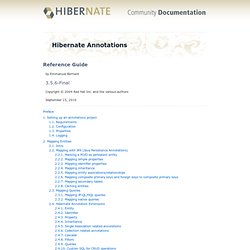
Download Hibernate Validator 4 or above from the Hibernate website and add hibernate-validator.jar and validation-api.jar in your classpath. Alternatively add the following dependency in your pom.xml. <project> ... IBM RAD - tutorial1. SpringMVC Hibernate CRUD Tutorial using Eclipse. Spring MVC 3, Hibernate Annotations, MySQL Integration Tutorial. In this tutorial we will build a simple Spring MVC 3 application for managing a list of persons.
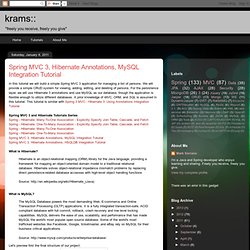
We will provide a simple CRUD system for viewing, adding, editing, and deleting of persons. For the persistence layer, we will use Hibernate 3 annotations and use MySQL as our database, though the application is flexible enough to utilize different databases. A prior knowledge of MVC, ORM, and SQL is assumed in this tutorial. Spring + JPA + Hibernate example. 27 December 2013 In this tutorial we will configure Spring with JPA using Hibernate as our JPA implementation.

Introduction Spring framework supports the persistence layer to be fully implemented through JPA. In this article we will see how to configure the Spring needed components to perform persistence over standard JPA, namely the Persistence Unit, the Entity Manager factory and the Transaction Manager. Spring Data: JPA (Hibernate), MySQL, Maven, MVC tutorial.
Java Persistence Example with Spring, JPA2 and Hibernate. This is sort of a follow up post for a previous post of mine – RESTful Web Services Example in Java with Jersey, Spring and MyBatis.
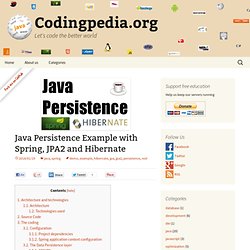
It is based on the same example application, which, via a REST API, can execute CRUD operations against a single Podcasts table. If in the first post the focus was on how to build the REST API with Jersey, this time it is on the data persistence layer. I will present how to implement a container-agnostic persistence layer with JPA2/Hibernate, being glued in the application via Spring. 1.
Architecture and technologies. Study Trails - Tutorials for Spring, hibernate, core Java, RJava. Spring Hibernate Integration Using Java Persistence API. Spring Hibernate Dao SupportSpring Hibernate Integration using SessionFactory JPA (Java Persistence API) - JPA is a persistence framework for Object Relational Mapping.
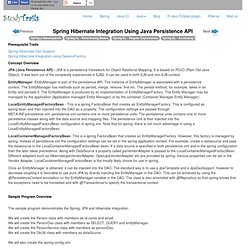
It is based on POJO (Plain Old Java Object). It was born out of the complexity experienced in EJB2. It can be used in both EJB and non-EJB context. EntityManager- EntityManager is part of the persistence API. Tutorials for Web Development Technologies. Freelance Jobs and Projects. String substring() Method. Description: This method has two variants and returns a new string that is a substring of this string.
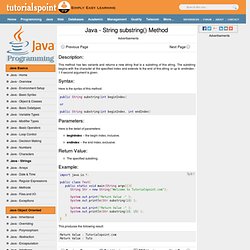
The substring begins with the character at the specified index and extends to the end of this string or up to endIndex - 1 if second argument is given. Syntax: Here is the syntax of this method: public String substring(int beginIndex) or public String substring(int beginIndex, int endIndex) Parameters: Here is the detail of parameters: beginIndex -- the begin index, inclusive.endIndex -- the end index, exclusive. Return Value: The specified substring.
Example: This produces the following result: HTML Code Tutorial - Free Reference Guide for Help with HTML Tags Including Form, Frames, Tables, and more! Spring Framework. Introduction The Spring Framework provides a comprehensive programming and configuration model for modern Java-based enterprise applications - on any kind of deployment platform.
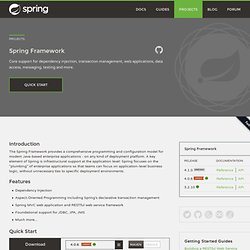
A key element of Spring is infrastructural support at the application level: Spring focuses on the "plumbing" of enterprise applications so that teams can focus on application-level business logic, without unnecessary ties to specific deployment environments. Features. Integrating JPA, JSF and EJB in Java EE7 Applications. There are several improvements in EE7; managed bean was introduced towards aligning Enterprise JavaBeans (EJBs), Java Server Faces (JSF) Managed Beans and Contexts and Dependency Injection (CDI) beans.

Java EE7 continues the legacy but with some significant changes - JSF Managed Beans has begun the pruning process in favor of CDI Beans. Use of @ManagedBean from javax.faces.bean is now deprecated; instead one should use @Named from javax.inject package to signify a managed bean as a JSF controller class. Also Java EE7 brought EJB container managed transactions to the platform as a whole, using CDI interceptors, so that these can be used by CDI managed beans and other Java EE components. The improvements and its convention over configuration with annotated POJOs that use little or no XML configuration, makes JSF, EJB and JPA integration simple. A Sample Application Coding the Entity Beans: JPA The @NotNull annotation specifies that those fields are required. Coding the Business Logic: EJB. Java. JSF 2.0 Tutorial. 17. Integrating with other web frameworks.
17.

Integrating with other web frameworks This chapter details Spring's integration with third party web frameworks such as JSF, Struts, WebWork, and Tapestry. One of the core value propositions of the Spring Framework is that of enabling choice. In a general sense, Spring does not force one to use or buy into any particular architecture, technology, or methodology (although it certainly recommends some over others).
This freedom to pick and choose the architecture, technology, or methodology that is most relevant to a developer and his or her development team is arguably most evident in the web area, where Spring provides its own web framework (Spring MVC), while at the same time providing integration with a number of popular third party web frameworks. Having dispensed with the woolly sales patter (c.f. the previous paragraph), the remainder of this chapter will concentrate upon the meaty details of integrating your favorite web framework with Spring.
First Hibernate Application. JSF 2.0 + Spring + Hibernate integration example. Here’s a long article to show you how to integrate JSF 2.0, Spring and Hibernate together.

At the end of the article, you will create a page which display a list of the existing customer from database and a “add customer” function to allow user to add a new customer into database.